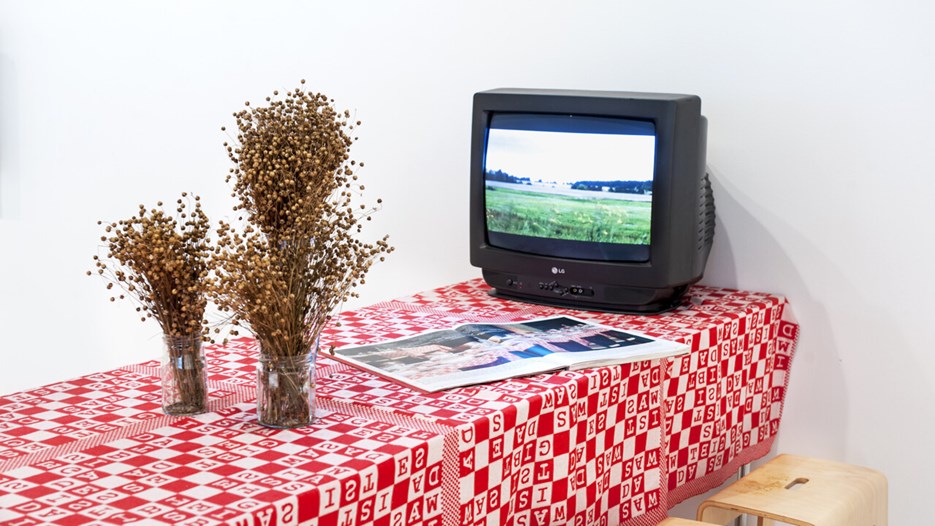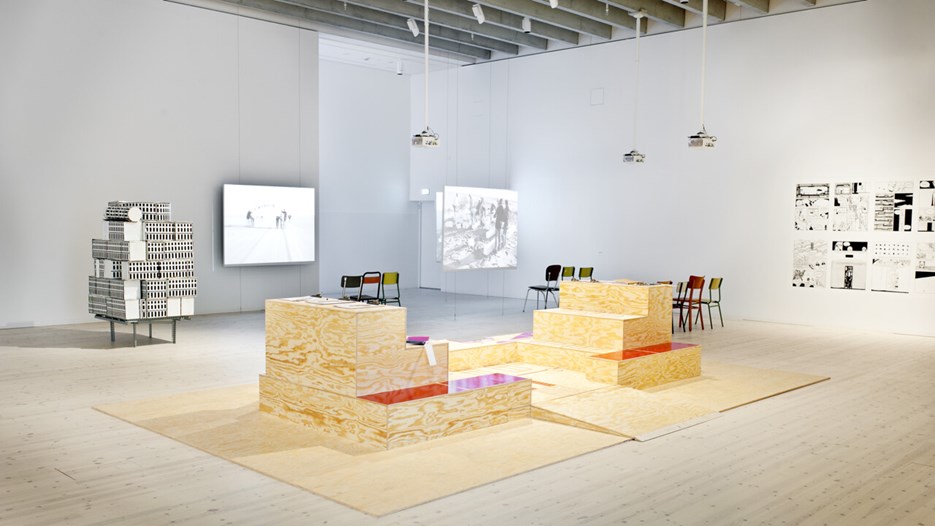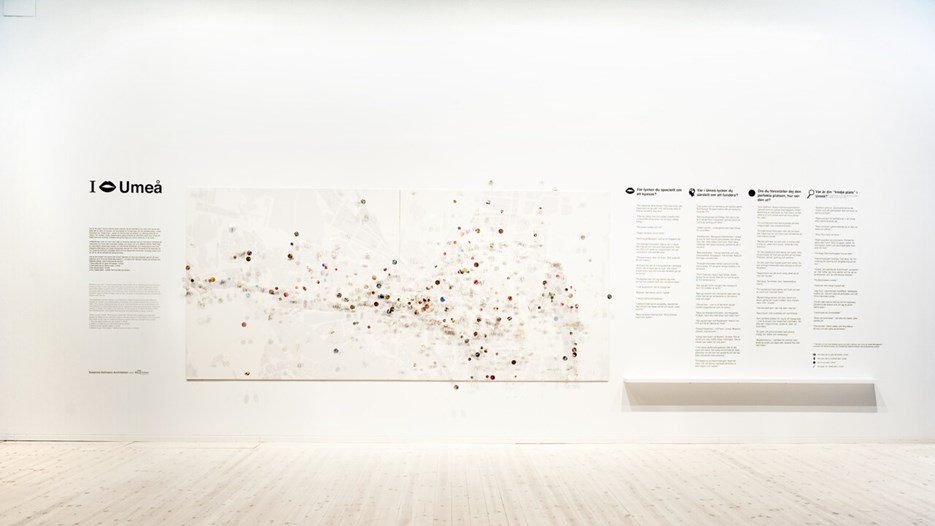
Communitas. From the exhibition at Bildmuseet 2012-2013.

Communitas. From the exhibition at Bildmuseet 2012-2013.

Communitas. From the exhibition at Bildmuseet 2012-2013.
The exhibition Communitas aims to inspire, excite curiosity and generate a debate about the city as our communal space.
What is our relationship to the city? What ideas and methods are available that can enable the creation of a better city, and who decides the course of future urban development? Can we find a way to make the city ours, if only for the moment?
Currently, Umeå is undergoing great change. New buildings are under construction and the city will be the European Capital of Culture in 2014. Communitas presents examples of artists' and architects' visionary ideas about the possible future of cities. Experimental strategies and playful interactions that create new stories in and about the city are displayed. The exhibition acknowledges different disciplines and methods of working. This is not necessarily a place for experts, nor for clear questions and answers, but is more of an open forum for innovative, untested approaches to cities and their inhabitants. Communitas is a Latin noun that refers to a society where people are equals, or to community spirit.
The artists and architects participating in the exhibition are: Die Baupiloten (Germany), Jordi Colomer (Spain), Jimenez Lai (USA), Listen to the City (South Korea), myvillages.org (Germany, the Netherlands and the UK), m7red (Argentina), Royce Ng (Australia), PKMN (Spain) and Rakett (Norway).
Royce Ng (Australien)
The Ballad of Zebadiah Arrington, 2012
The Ballad of Zebadiah Arrington is an animated film based on the American street artist Arrington's experiences in Chicago, New York and Boston, where he has spent time in prison as a result of his graffiti activities. Royce Ng met Arrington while he was staying in Gwangju, South Korea as an artist-in-residence, and in this film, he imagines the city environments and prisons that were described to him. The animation is interwoven with filmed sequences showing Arrington spraying graffiti in Gwangju. The work reflects Arrington's experiences in relation to the Korean legend Chunhyangjeon. The music in the film is pansori opera, traditional Korean music that retells the story of Chunhyangjeon. In that way, the work reflects local history as well as the circumstances under which it was created.
PKMN (Spanien)
Communitas Monubench, 2012
PKMN has designed a "monubench" for the exhibition, a combination of a monument and a bench. In this case, Umeå Town Hall has been used as inspiration for the design of the bench, which also acts as a meeting point in the exhibition room. PKMN is an architectural practice in Madrid that examines cities in relation to their inhabitants, often with the aid of academically designed games. They work with local monuments and like to play around with the dimensions of them so as to make them more accessible to the city's population. Today, many cities seek to create an individual "identity", either by glorifying their pasts or highlighting their modernity. The city's identity becomes a brand in the quest to attract inward investment and make it more attractive for tourists.
Rakett (Norge)
Space, Conflict, Freedom and Change (Kolhaas, Deutsche, Saab and Kohn), 2012. I samarbete med Jaan Evart
Having used Oslo and Umeå as the focus for their urban investigations, the Norwegian artist duo Rakett - Åse Lövgren and Karolin Tampere - contribute a series of posters to the exhibition which express ideas about public space. Together with Expodium (the Netherlands), Rakett will also host a discussion and an evening walk where they will talk about art and architecture in Umeå. Rakett work with curatorial projects, often with an interdisciplinary starting point. Their projects work as lively, temporary platforms, a stage where people from different creative fields can come together. Expodium are a Dutch collective that work with urban environments in transition.
Susanne Hofmann Architects and Die Baupiloten (Tyskland)
The installation shows how the commitment of the inhabitants can produce new perspectives and give rise to new questions about the future of our cities. Die Baupiloten use different methods to explore how people perceive the city they live in. They have asked residents of Umeå to talk about their city, and these stories can be used to discuss alternative visions for the Umeå of the future. Die Baupiloten was created in 2003 as a collaboration between Technische Universität Berlin and Susanne Hofmann Architects. The architecture students participate in the projects, from conception to completion - ongoing experiments, execution and evaluation in real contexts. Research, teaching and architectural practice are combined to develop alternative ways of engaging inhabitants and decision makers in the production of our built environment.
Jordi Colomer (Spanien)
L'Avenir, 2011
L'Avenir (the Future) is piece that combines film and three-dimensional architectural models. It alludes to the French philosopher Charles Fourier's famous Phalanstère, an architectural utopia with a contradictory design that is far removed from reality. The film shows a group of people who, like pioneers, have decided to conquer the future. In the desert-like Ebro Delta, south of Barcelona, they carry a scale model of Fourier's utopia. The model cannot describe the complexity of Phalanstère, and the work reminds us of the opposition all architecture faces in its relationship to the reality into which it is placed. Thanks to Joost and Siska Vanhaerents' collection, VanhaerentsArtCollection, Brussels, Belgium.
Jimenez Lai (USA)
Ur serien Babel, 2011
Jimenez Lai imagines alternative worlds and uses architectural elements to tell his stories. The stories are beautiful and revolve around subjects such as relationships, curiosity and attitudes. The stories are often absurd, telling tales about false realities, but also opening up new possibilities and ways of thinking. In the cartoons, design, theory, critique and history all meet. Sometimes his graphic stories also take a physical form through architectural installations, models and small buildings. Jimenez Lai is an Assistant Professor at University of Illinois at Chicago and Leader of the architectural practice Bureau Spectacular.
Listen to the City (Sydkorea)
Urban Film Festival, 2011
The film festival Listen to the City was started in order to create a dialogue between the inhabitants of different parts of Seoul. It is primarily about the hard reality that one is faced with when developing South Korean cities, but also about man's relationship to nature. The exhibition will show a selection of works from the film festival programme, which was shown in its entirety in Seoul in 2011. The films showing are: Sanggyedong Olympic by Kim Dong-won, The Structure of Goliath by Kim Kyung-man, 2 Doors by Hong Ji-you/Kim Il-rhan, Yongsan by Jeong-hyun Mun, Still Alive by Kim Sung-man, River Workers by Kim Jun-ho/Park Chae-eun and Seoul Tours by Listen to the City.
myvillages.org (Tyskland/Nederländerna /Storbritannien)
Vorratskammer, 2010-2012
Vorratskammer (The Pantry) was developed when the artists in myvillages.org were invited to the festival Über Lebenskunst in Berlin in 2011. Over the course of a year, they worked with local food producers in Berlin to fill the larder. The idea was to offer food to 5,000 people during the festival, but 8,000 turned up. The film tells the story of the meetings and processes that took place during the project in order to collect and produce the food. myvillages.org is Kathrin Böhm, Wapke Feenstra and Antje Schiffers.
m7red (Argentina)
Inhabiting the Interlacings. A Cartography of Glocalization for Umeå, 2012
The installation shows a "glocal" map of Umeå incorporating various objects linked to the city and the region. The selected objects work as the delegated spokespeople for a number of processes that are currently transforming Umeå. Through the intricately interwoven contexts that these objects are part of, they contribute to the story of Umeå's future. m7red is a network in Buenos Aires with its own archive, laboratory and advisory office. It was founded by Mauricio Corbalan and Pio Torroja in 2005, and since then, m7red have analysed, discussed and drawn up proposals on how to deal with urgent political and urban issues. They work as a research group, as urban consultants and as a strategic forum.